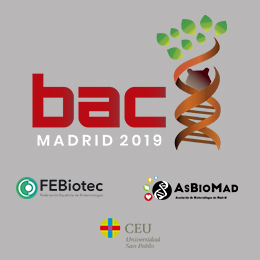July, 2019 news
July 25th, 2019
Via publiDB

The bla NDM-1 carrying IncA/C2 plasmid underlies structural alterations and cointegrate formation in vivo
Antimicrobial Agents and Chemotherapy publish this investigation article
In 2012, a carbapenemase-producing Salmonella (S.) Corvallis carrying a bla NDM-1 multi-resistance IncA/C2 plasmid, apart from IncHI2 and ColE-like plasmids, was detected in a wild bird in Germany. In recent broiler chicken infection study, we observed transfer of this bla NDM-1-carrying IncA/C2 plasmid to other Enterobacteriaceae Here, we focused on the stability of this plasmid and gained insight into type and frequency of its structural alterations after an in vivo passage in a broiler infection study…
Read more
July 25th, 2019
Via publiDB

IdentificaciĂłn de factores predictores de virulencia en cepas de Mycobacterium bovis
Alberto GĂłmez BuendĂa defended this Degree Final Project
July 25th, 2019
Via publiDB

DetecciĂłn molecular de Trypanosoma cruzi en pelo de ratĂłn infectado experimentalmente
Degree Final Project defended by Silvia DĂaz Franchy
Trypanosoma cruzi es el parásito protozoo causante de la enfermedad de Chagas, que afecta entre 6 y 8 millones de personas. Es una enfermedad transmitida principalmente por insectos de la familia Reduviidae, aunque tambiĂ©n se puede transmitir por vĂa oral, mediante transfusiones o vĂa congĂ©nita. Se trata de una enfermedad infradiagnosticada en Europa, siendo España el paĂs europeo con mayor nĂşmero de personas afectadas por T. cruzi. En los paĂses endĂ©micos los animales salvajes suponen uno de los principales reservorios, haciendo el manejo y obtenciĂłn de muestras difĂcil. Por tanto…
Read more
July 24th, 2019
Vía cazaworld.com
Un repunte de los casos de PPA recomienda adoptar medidas de prevenciĂłn
Repunte en Peste Porcina Africana
July 16th, 2019
Via publiDB

Certificado de Ensayos MicrobiolĂłgicos y BiotecnolĂłgicos
Communications in this event:
July 13rd, 2019
Via publiDB
The pig plague
Interview in The Food Chain of British Broadcasting Corporation
July 10th, 2019
Via publiDB
Desarrollo y puesta a punto de una técnica de base inmunológica para la detección conjunta de ricina y aglutinina
Presentation by Virginia Colmena Garcia to obtain the Master in Disaster Management
La ricina es una de las toxinas más potentes conocidas, que se encuentra en la semilla del ricino (Ricinus communis). El Centro para el Control y la PrevenciĂłn de Enfermedades de Estados Unidos (CDC) la clasifica como posible arma biolĂłgica. Existen diferentes mĂ©todos para la detecciĂłn de esta proteĂna, siendo la tĂ©cnica inmunolĂłgica ELISA, especialmente el ELISA tipo sándwich, la que está considerada como la tĂ©cnica más robusta para su análisis, ya que es sensible, especĂfica, con lĂmites de detecciĂłn de picogramos y fácil de realizar. No obstante, el reto está en poder dife…
Read more
July 10th, 2019
Via publiDB

Visita al centro VISAVET
Conference in XIII Congreso Anual de BiotecnologĂa
July 8th, 2019
Via publiDB

Pathology Live!
Poster presented in V Congreso de Docencia Veterinaria (VetDoc)
July 5th, 2019
Via publiDB

Circulation of a novel strain of dolphin morbillivirus (DMV) in stranded cetaceans in the Mediterranean Sea
Investigation article published in Scientific reports
Dolphin morbillivirus (DMV) has been responsible for several outbreaks of systemic infection and has resulted in cetacean strandings in the Mediterranean. In August-October 2016, seven striped dolphins (Stenella coeruleoalba) stranded on the Sicilian coastline (Italy) tested positive for DMV. Tissue samples from brain, lung, pulmonary lymph nodes, heart, spleen, liver, stomach, intestine, kidneys and urinary bladder, as well as blowhole swabs, were collected during necropsy for molecular diagnostics and pathology studies. Extracted tissue RNA was screened for DMV by real-time reverse transcrip…
Read more
July 4th, 2019
Via publiDB
Nucleotide sequence variations may be associated with virulence of deformed wing virus
Investigation published in Apidologie
Western honey bees (Apis mellifera) are key players in crop pollination and in the maintenance of global biodiversity. Their viability is threatened by Varroa destructor, which acts as a vector of the deformed wing virus (DWV). Several genetic DWV variants have been reported, but it is unclear whether their virulence differs. We examined the prevalence of V. destructor and DWV as well as bee health in two colonies over 21 months and then characterizing DWV variants from each colony using phylogenetics. Colony H showed no signs of disease or mortality, and DWV sequence from this colony clustere…
Read more
July 3rd, 2019
Via publiDB

Evaluation of the health status of the main aquaculture species in Papua New Guinea
PhD Thesis defense by Ruth GarcĂa GĂłmez at the VISAVET Centre of the Complutense University of Madrid
The aquaculture sector has been strongly promoted y developed in a technically feasible, economically viable y long-term sustainable way in the Pacific Region for more than two decades. Numerous international, intergovernmental, regional agencies y programs have focused their economic y human efforts on the sustainable development of this sub-sector (within the fisheries sector) in the Pacific, with limited results y not many successful stories. The Oceania region remains the world`s least developed region in the world`s aquaculture sector, with some exceptions such as Australia y New Zealy, f…
Read more
July 2nd, 2019
Via publiDB

Animal welfare epidemiology: how epidemiologists help to improve the welfare of animals
Conference in Seminarios VISAVET 2019
Animal welfare epidemiology is a rapidly growing area in veterinary science. Epidemiology offers the methodology to quantify the welfare impact of individual diseases on the animals, compare the impact among different diseases and facilitate disease prioritisation. Animal welfare science extends the focus of veterinary epidemiology − animal health – to a broader sense of animal well-being. The concept of animal welfare epidemiology is then demonstrated by the epidemiological studies on the impact of feline obesity on the survival and health in cats, follow by Welfare-Adjusted Life Year…
Read more
July 1st, 2019
Via publiDB

Effect of litter aggregation and pooling on detection of porcine reproductive and respiratory virus in piglet processing fluids
Investigation published in Journal of Veterinary Diagnostic Investigation
A sampling technique has been validated to monitor porcine reproductive and respiratory syndrome virus 2 (PRRSV-2) using the serosanguinous exudate known as processing fluids (PFs) that accumulate from tissues obtained during tail docking and castration. PFs are an aggregate sample of large numbers of piglets and litters. However, little is known about the effect of litter aggregation on the ability of PCR to correctly classify an aggregated PF sample as positive. We evaluated both the effect of litter aggregation and of PF pooling on PCR detection. We estimated that aggregation of at least 50…
Read more
July 1st, 2019
Via publiDB
Seroprevalence of Brucella canis antibodies in dogs entering a Minnesota humane society, Minnesota, 2016-2017
Preventive Veterinary Medicine publish this investigation article
Background: Canine brucellosis, caused by the bacterium Brucella canis, is a zoonotic and largely reproductive disease of dogs. The disease is a recognized problem in canine breeding populations, and the risk to individuals assisting with birthing is well described. Prior to 2015, all cases of canine brucellosis reported to the Minnesota Board of Animal Health were in dogs used for breeding. In 2015, canine brucellosis was identified in eight Minnesota rescue dogs, all originating from specific geographic areas in South Dakota. Our objective was to measure the seroprevalence of B. canis in str…
Read more
July 1st, 2019
Via publiDB
The possible route of introduction of bluetongue virus serotype 3 into Sicily by windborne transportation of infected Culicoides spp
Investigation article published in Transboundary and Emerging Diseases
In October 2017, the first outbreak of bluetongue virus serotype 3 (BTV-3) began in Italy, specifically in western Sicily. The route of entrance remains unclear, although since 2016 the same strain had been circulating only 150 km away, on the Tunisian peninsula of Cape Bon. The present analysis assessed the feasibility that wind could have carried BTV-3-infected Culicoides spp. from Tunisia to Sicily. An advection-deposition-survival (ADS) model was used to estimate when and where Culicoides spp. were likely to be introduced prior to the first BTV-3 report in Italy. Additionally, the Hybrid S…
Read more
July 1st, 2019
Via publiDB
Potentially human-virulent Vibrio vulnificus isolates from diseased great pompano (Trachinotus goodei)
Transboundary and Emerging Diseases publish this investigation article
Vibrio vulnificus is an opportunistic human pathogen responsible for the majority of seafood-associated deaths worldwide and is also a relevant fish pathogen for the aquaculture industry. In addition to infections in aquatic livestock, Vibrio vulnificus also represents a risk to aquarium animals. For the first time, this work describes an important mortality outbreak in Trachinotus goodei in a zoo aquarium, with the isolation of Vibrio vulnificus (Vv) from the internal organs of the diseased fish. The isolates were identified by MALDI-TOF MS, serotyped and characterized by PFGE. Although the i…
Read more


